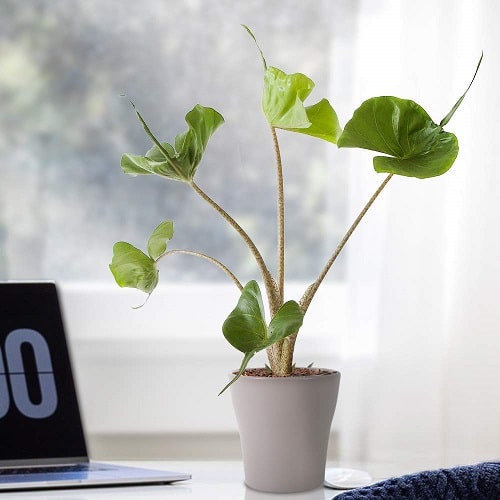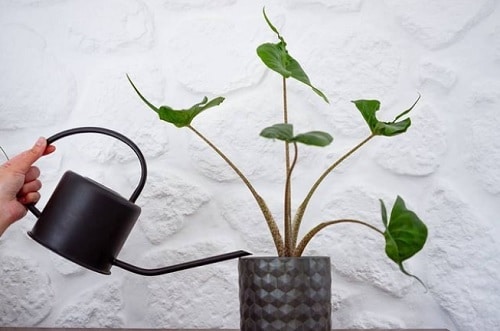If you are looking for an exotic indoor plant, then the Elephant Ear Stingray is ideal for your home! Here’s everything on Alocasia Stingray Care Indoors.
If you want an indoor plant that stands out from the rest, then Elephant Ear Stingray is the best bet! Its leaves might not be as big, but it makes its impact with a distinctive “tail” and “wings” on its foliage! Here’s all you need to know about Alocasia Stingray Care Indoors.
Botanical Name: Alocasia macrorrhiza ‘Stingray’
Here are the best Alocasia varieties you can grow
Propagating Alocasia Stingray

The plant is quite easy to grow, and you can propagate it by rhizome division, and offsets. The best form of propagation is rhizome division. To do it:
- Carefully remove the plant from the pot and wash the roots and allow them to dry. This will make you see offsets and clusters more clearly.
- Now, using a clean pair of a blade or a knife, separate the rhizomes.
- Plant them into individual containers in a quality potting mix. Water well and keep them at a location where they can get bright, indirect light.
- Re-pot the donor plant back into the soil using a fresh potting mix.
Requirements for Growing Alocasia Stingray Indoors

Location
This plant loves indirect light, and direct sunlight or heat can burn the leaves. Keep it by a south or east-facing window. Also, avoid changing the location abruptly and give time to the plant to get accustomed to the new light source.
When you move the plant from a shady location to a bright location, make sure to do it in stages. A sudden move can shock your plant and leave it distressed for a few weeks.
Soil
The plant thrives in a well-draining soil mix. You can also mix equal parts of soil, peat, and perlite. The Stingray loves slightly acidic soil. If you have a tester, aim for a pH of 5.5 to 6.5.
Watering
When it comes to watering, always keep a watering schedule, so you don’t overwater or underwater. Always keep the soil moist but make sure that it is not overly wet. The best method is to keep an eye on the topsoil and water only when it gets dry. Increase the rate in summers and cut it down in winters.
Temperature & Humidity
The ideal environment for a Stingray is a hot and humid one. Get a humidifier to ensure the plant stays happy all the time. It does best in the temperature range of 64-74 °F (18-22 °C). Never expose the plant to a temperature below 50°F (10°C).
Alocasia Stingray Care Indoors

Fertilizer
Use an all-purpose liquid fertilizer once in 3-4 weeks in the spring when it is actively growing. You don’t have to fertilize the plant for the rest of the year. Refer to the label for dosage and instructions.
Re-Potting
When you start to see the visible roots on the topsoil, it is time to re-pot the plant. Use a size bigger pot than the old one and always go for a fresh potting mix.
Pests & Diseases
Be careful of mealybugs, spider mites, and aphids. They can induce a lot of harm to the plant. The best part is, they are easy to take care of using a strong jet of water or insecticidal soap.
Browning of the leaves is another problem. This could be due to over-fertilization or an arid or hot location. Yellow leaves indicate overwatering, which may also cause root rot.
Is It Safe for Cats and Dogs?
As the plant’s leaves contain calcium oxalate, it can create breathing problems and swelling if ingested. Keep it where your pets can’t reach the plant.
Some Quick Points to Remember
- Fading of leaves and dropping during wintertime is normal.
- DO NOT keep the plant in direct sunlight.
- You can also keep the plant on a bathroom window as it LOVES humidity.
- Always use a pot with a drainage hole at the bottom.
- Reduce the rate of watering in winter.


